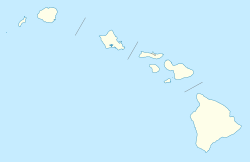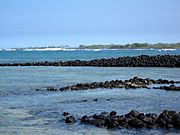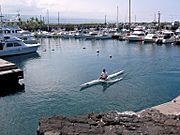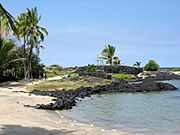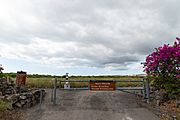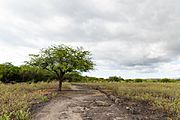Kaloko-Honokōhau National Historical Park facts for kids
|
Kaloko-Honokohau National Historical Park
|
|
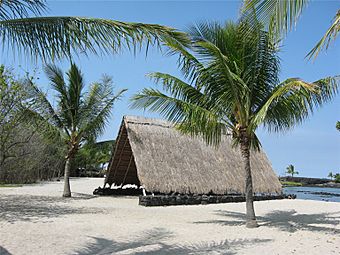
Honokōhau Hālau
|
|
| Location | Hawaii County, Hawaii, United States |
|---|---|
| Nearest city | Kailua Kona, Hawaii |
| Area | 1,161 acres (470 ha) |
| Architectural style | Dry stack masonry |
| Visitation | 153,584 (2012) |
| Website | Kaloko-Honokōhau National Historical Park |
| NRHP reference No. | 78003148 |
Quick facts for kids Significant dates |
|
| Added to NRHP | November 10, 1978 |
| Designated NHL | December 29, 1962 |
Kaloko-Honokōhau National Historical Park is a special place in Hawaiʻi, on the Big Island. It's a United States National Historical Park that helps protect and share the amazing history and culture of the native Hawaiian people.
This park includes an important old site called the Honokōhau Settlement. The park was created on November 10, 1978. Its main goal is to keep traditional Hawaiian activities and culture safe and to teach people about them.
Discovering the History of Kaloko-Honokōhau Park
The park is named after two of its main areas: Kaloko and Honokōhau. These are parts of what Hawaiians called ahupuaʻa. An ahupuaʻa was a traditional land division. It stretched from the mountains all the way to the sea.
Even though this area was once very dry and rocky, it had lots of sea life. This made it a great place for people to live for hundreds of years.
The Ancient Kaloko Fishponds
Kaloko means "the pond" in the Hawaiian language. This area, on the north side of the park, has ancient fishponds. Hawaiians used these ponds to raise fish.
The first stories about this pond are from about 300 years ago. They tell about a person named Kamalalawalu.
Building the Seawall at Kaloko
The kuapā (seawall) at Kaloko is very impressive. It is over 30 feet wide and 6 feet high. It stretches for 750 feet along the coast.
This wall was built by hand using stones, without any mortar. The way the stones were placed helped the wall handle ocean waves. It worked better than many modern concrete walls.
ʻAimakapā Fishpond: A Bird Sanctuary
The ʻAimakapā fishpond is a very important wetland area. It helps protect many native Hawaiian birds.
Some of these special birds include:
- the koloa maoli (Hawaiian duck)
- the ʻalae keʻokeʻo (Hawaiian coot)
- the āeʻo (Hawaiian stilt)
- the auʻkuʻu (black-crowned night heron)
Today, people are working to replant native trees and plants here. They are also removing plants that don't belong and can harm the area. The Kaloko fishpond was added to the Register of Historic Places in 1978.
Exploring Honokōhau Settlement
Honokōhau means "bay drawing dew." This name refers to the old settlement on the south side of the park. You can reach this area by walking on trails from the park visitor center. You can also get there from the small boat harbor road.
What You Can See at Honokōhau
This area has many interesting historical features:
- loko iʻa (ancient Hawaiian fishponds)
- kahua (platforms where houses used to be)
- kiʻi pōhaku (petroglyphs, which are carvings in rock)
- hōlua (stone slides used for a sport like sledding)
- heiau (religious sites or temples)
The ʻAiʻopio Fishtrap
The ʻAiʻopio Fishtrap is a 1.7-acre pond. It has a stone wall that forms a special enclosure along the bay's natural curve. Small openings in the wall allowed young fish to swim in from the sea. As the fish grew bigger, or when the tide was low, they could be easily caught with nets inside the trap.
This fishtrap was named a National Historic Landmark in 1962. It was added to the National Register of Historic Places in 1966.
Fun Activities at the Park
Kaloko-Honokōhau National Historical Park offers several ways to explore and enjoy its beauty.
Walking the Historic Trails
You can walk on several restored trails in the park. About one mile of the Māmalahoa Trail is here. This trail was built in the mid-1800s. Over time, it became part of the Hawaii Belt Road, which goes around the entire island.
The coastal trail in the park is also part of the Ala Kahakai National Historic Trail. This trail follows ancient Hawaiian pathways along the coast.
Boating and Water Sports
The Honokōhau boat harbor is a great place for water activities. You can launch traditional canoes here. Fishing boats also use the harbor. Many people enjoy Scuba diving and snorkeling tours to see the amazing underwater world.
Gallery


